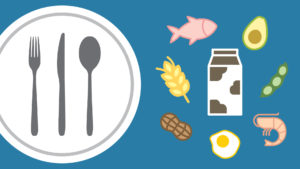Living With Allergies
Growing up with an allergy, I always felt like “that girl.” That girl who couldn’t have the birthday cupcakes; that girl who didn’t have a favorite chocolate bar; that girl who wasn’t eating the slice of pizza at the class pizza party. When I was younger, I felt like I was the only person in the world with a life-threatening allergy. I know now that obviously isn’t true. According to Food Allergy Research and Education (FARE), about 1 in 13 children have some sort of food allergy. And 40% of those children with food allergies have experienced a serious reaction like anaphylaxis1. Anaphylaxis is “a severe, potentially life-threatening allergic reaction… [it] causes your immune system to release a flood of chemical that can cause you to go into shock.”2 Unfortunately, I was one of these children. Remember, there’s a difference between “allergy” and “intolerance.” I am severely allergic to all dairy products. Yes, you read that right. Dairy. Like butter, cheese, and milk. Those are the obvious ones. But don’t forget about lotion with milk enzymes, restaurants that cook their hamburgers and cheeseburgers on the same grill, oh and the steamed milk particles floating in the air at Starbucks. All of these hidden culprits have landed me in the emergency room. Over the course of my life, I’ve ended up in the emergency room at least a dozen times due to undeclared dairy products. Although, if I’m being honest, some of those times were also just out of sheer neglect on my part. It’s hard and time-consuming to be aware of every single ingredient that is in every single food that I ingest. Sometimes I was just plain lazy and didn’t double check.

Being “that girl” when I was younger was tough. There was really no awareness around allergies. Sure, people knew about peanut and shellfish allergies, but milk? Who’s allergic to milk?! I was told by my allergist when I was a kid that I would “definitely” outgrow this allergy by the time I was 14. So began that countdown to my fourteenth birthday. Fourteen came and went, as did 15, 16, and all of the birthdays after that. And here I sit, quite a few years past 14, drinking my coffee with almond milk, eating my toast with vegan “buttery spread.” As disappointing as it is to finally admit that perhaps my allergist may have been wrong, my diet is so much different now than it was when I was younger because of the
progress the food industry has made. Fortunately and unfortunately, a lot of this is due to the fact that more kids are being diagnosed with food allergies. Awareness has increased, diets have shifted towards more dairy-free options, and, thus, I benefit. From the dairy-free cheese options, to milks, to sour cream and candy bars, I can almost have the same diet as the rest of my friends and family.
While I am thrilled at all of the progress that has been made in the awareness and research of food allergies, there have been some downfalls as well. If there is one thing I wish I could share with the world about allergies it is that there is a big difference between an allergy and an intolerance. Further, when I say I have an allergy, please take me seriously. I’m not trying to make the waitstaff’s life harder at a restaurant. It’s not just that I prefer my sandwich without cheese, or that it will make me gassy. It will land me in the hospital with my airways closing, my blood pressure dropping, and my body going into all out fight-or-flight mode. I’ve known I am allergic to dairy for my whole life. I got sick eating whipped cream as a baby and allergy tests confirmed the suspicion. I’m used to reading ingredients and I know what is generally safe to eat and what is not. Sometimes I still feel like “that girl,” but I’ve learned that my allergy doesn’t have to control my life. Now, more and more people are learning about their allergies later in life. If you think you might have a food allergy, talk to your doctor right away. They can help you figure out what steps to take to find out.
Sources:
1https://www.foodallergy.org/life-with-food-allergies/food-allergy-101/facts-and-statistics
2 https://www.mayoclinic.org/diseases-conditions/anaphylaxis/symptoms-causes/syc-20351468